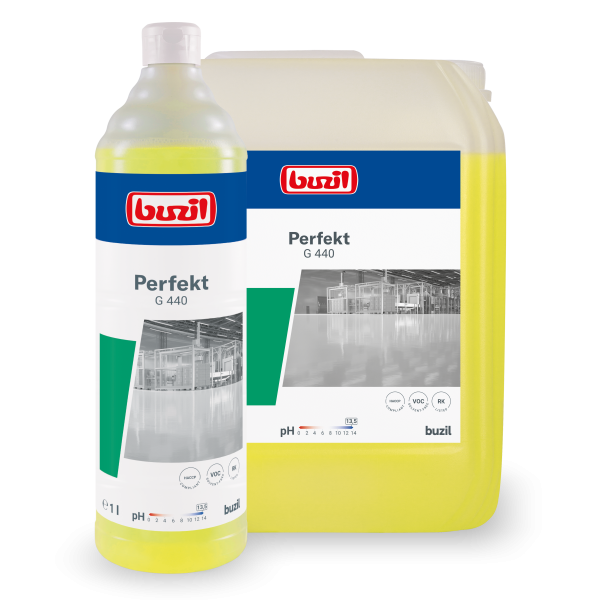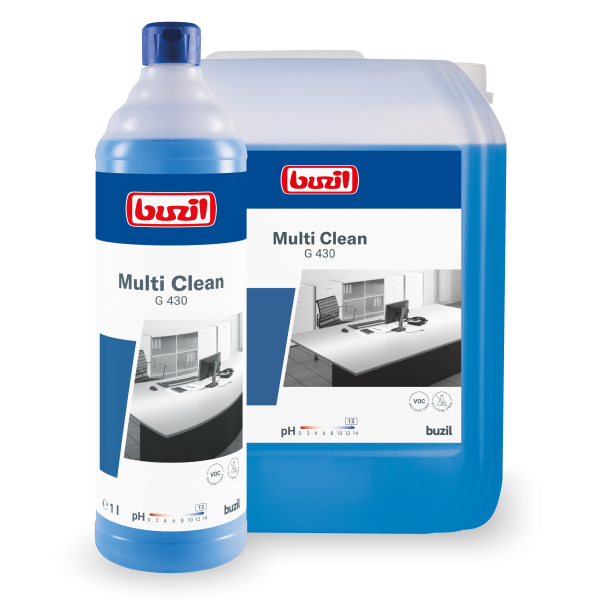Utilization
Soiling
-
Organic / inorganic contamination (grease, oil, protein, starch etc.)
-
Normal soiling (dust, beverage stains, insect stains, etc.)
-
Oxidation and adherent contamination (corrosion, incrustations, etc.)
Material compatibility
-
Cast stone and terrazzo | bitumen-bound
-
Resopal
-
Chrome
-
PVC safety flooring
-
Asphalt flooring
-
Ceramic hobs
-
Clinker and terracotta
-
Synthetic resin filler coverings
-
Porcelain stoneware tiles
-
Safety tiles
-
Quartz vinyl
-
Ceramic tiles
-
Ovens, grills and convection ovens
-
Stainless steel
-
Granite
-
Washed concrete
Product Information
- Excellent cleaning effect for oil and grease
- Low-foaming
- Suitable for high-pressure cleaners
- RK-listed
- RE-listed
- Halal certified according to HALAL CONTROL
- Meets the requirements within the framework of an HACCP concept
- Proven in fire restoration applications
- Pleasant fragrance
Area of application
- Industrial plants, workshop floors, commercial kitchens and gastronomy, food processing industry
- solvent-sensitive floors
Application and dosage
- Always use cold water.
-
50 - 200 Millilitre / 10 liter Water
-
1:5 - 1:10 with water
-
50 Millilitre / 10 liter Water
-
50 Millilitre / 10 liter Water
- Apply fresh application solutions and consume them within 24 hours at the latest.
Note
- Surfaces or objects that come into direct contact with food must be cleaned of cleaning residues by careful rinsing with water.
- When using hard water (>14 °Dh) it is recommended to increase the concentration.
- When used in the machine, the tanks should be cleaned and rinsed regularly.
- Any precipitation, colour changes or differences have no impact on product quality.
- Changes or variations in colour of the product do not impact on the quality. The product image may differ in colour and shape from the original.
Tips and tricks
Stripes and/or film on the surface, too much foam
Adjust product dosage
Surface damage (discoloration, swelling of material, etc.)
check chemical and water compatibility
low / weak cleaning performance
choose an alkaline intensive cleaner, e.g. Indumaster® Intensive IR 44, Indumaster® Strong IR 45, Bistro G 435
Environmental Information
Proportion of easily degradable ingredients
98.8 %
Phosphorus content
17.3 mg/g
Palm oil-based raw materials - RSPO-certified share
100 %
The proportion of easily degradable ingredients refers to the proportion of organic ingredients that are defined as “easily biodegradable” according to OECD 301 or Detergent Regulation (EC) No. 648/2004. The value of the phosphorus content refers to elemental phosphorus. Palm oil is an important renewable source for the production of raw materials. The Roundtable on Sustainable Palm Oil (RSPO), founded in 2004, promotes sustainable cultivation methods for palm oil. This results in a certification system and the possibility of declaring raw materials as “RSPO-certified”.
Sales units
- G440-0001RA: 12 x 1 l bottle
- G440-0005RA: 1 x 5 l canister
- G440-0010RA: 1 x 10 l canister
- G440-0750RA: 1 x 750 l IBC container
- G440-0200RA: 1 x 200 l drum
Classification according to CLP
Danger marking
Danger
Hazard information
- H290: May be corrosive to metals.
- H318: Causes serious eye damage.
Safety instructions
- P280: Wear protective gloves/protective clothing/eye protection/face protection.
- P305+P351+P338: IF IN EYES: Rinse cautiously with water for several minutes. Remove contact lenses, if present and easy to do. Continue rinsing.
- P310: Immediately call a POISON CENTER/doctor.
Download area
- Operating instructions
- Halal
- Safety Data Sheets
- Technical Data Sheets
- Environmental Information



